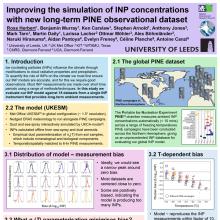Improving the simulation of ice-nucleating particle concentrations with a new long-term observational dataset from PINE instruments
Ross
Herbert
University of Leeds
Poster
In order to understand the role of ice-nucleating particles (INPs) in the climate system we need to accurately simulate the abundance and activity of INPs in climate models. To achieve this, we require observational datasets that can provide a robust evaluation. In previous efforts we have used datasets that include measurements from numerous field campaigns and laboratory studies. However, the wide range of techniques and instruments used to measure INPs results in the potential for considerable uncertainty. Additionally, the timescales on which the measurement campaigns are made tend to vary from days to weeks, providing limited opportunity to test and improve the model.
Here we bring together INP measurements made using multiple Portable Ice Nucleation Experiment (PINE) instruments from recent campaigns in the northern hemisphere and use the collective dataset to evaluate simulated INP concentrations with the UK climate model UKESM. The long-term nature of the campaign measurements (up to multiple years), high temporal resolution, and ability to scan through multiple freezing temperatures, provides an unparalleled dataset for INP/model evaluation. With this, we can resolve distinct air masses and INP sources throughout the annual cycle, allowing us to test the model’s ability to represent the production, transport, and loss of key INP species. This has not previously been possible.
The scale of the database allows us to robustly evaluate the model, and obtain statistical information on the model’s performance at a range of temperatures, over multiple seasons, and varied locations. Initial results show strong regional differences in the ability of the INP model to reproduce the measured concentrations. However, when accounting for a spatially varying contribution of biogenic material to dust particles, we can account for the regional discrepancies, and improve the representativeness of our INP model. This highlights the benefit of making long-term measurements using a consistent technique.
Here we bring together INP measurements made using multiple Portable Ice Nucleation Experiment (PINE) instruments from recent campaigns in the northern hemisphere and use the collective dataset to evaluate simulated INP concentrations with the UK climate model UKESM. The long-term nature of the campaign measurements (up to multiple years), high temporal resolution, and ability to scan through multiple freezing temperatures, provides an unparalleled dataset for INP/model evaluation. With this, we can resolve distinct air masses and INP sources throughout the annual cycle, allowing us to test the model’s ability to represent the production, transport, and loss of key INP species. This has not previously been possible.
The scale of the database allows us to robustly evaluate the model, and obtain statistical information on the model’s performance at a range of temperatures, over multiple seasons, and varied locations. Initial results show strong regional differences in the ability of the INP model to reproduce the measured concentrations. However, when accounting for a spatially varying contribution of biogenic material to dust particles, we can account for the regional discrepancies, and improve the representativeness of our INP model. This highlights the benefit of making long-term measurements using a consistent technique.

Herbert-Ross-poster.pdf
(1.07 MB)
Meeting homepage
